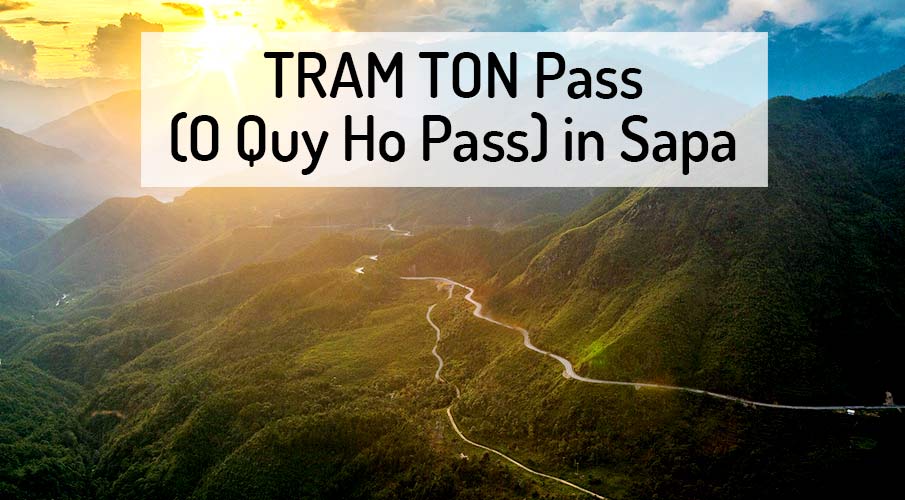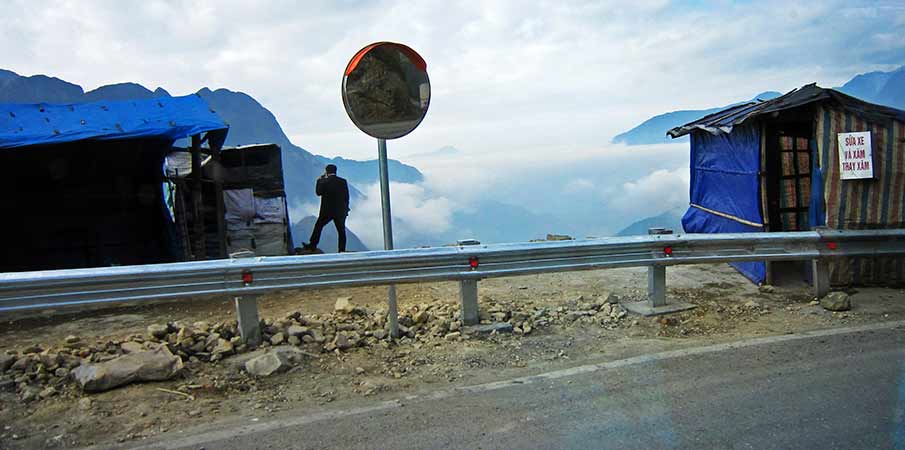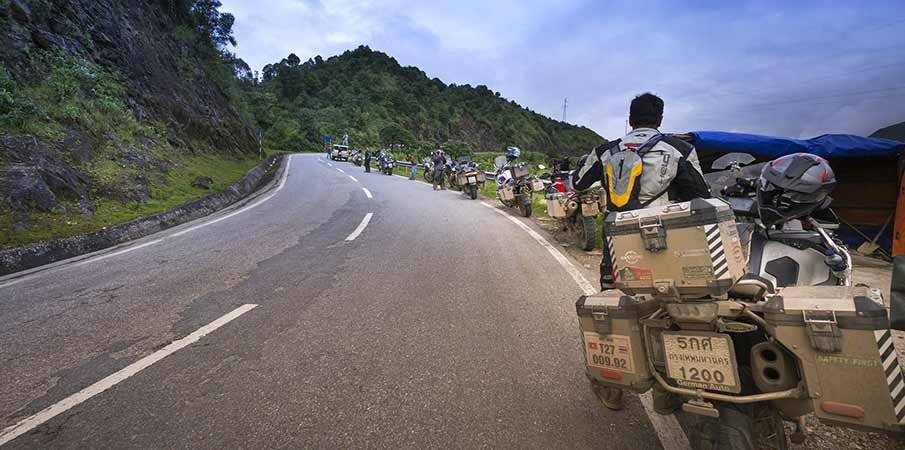
ℹ️ Information – Tram Ton
🚶 How to get to Tram Ton
☀️ When to go to Tram Ton
🏡 Where to stay in Sapa
❓ FAQ + Travel Tips
🎫 Book a Tour in Sapa
🎫 Book Tickets to Sapa
Tram Ton Pass is located near the popular tourist town of Sapa.
-
- Sapa city is one of the most visited tourist destinations in northern Vietnam. The city of Sapa and its surroundings offer various tourist activities and interesting places, the opportunity to try a homestay in nature, trekking, or a visit to the highest mountain in Vietnam – Fansipan. It is located in the province of Lao Cai and recently this place has also changed a lot. You can go to the highest mountain Fansipan by train + cable car via Muong Hoa station, new tourist resorts and hotels have been build and the number of tourists has increased. Just north of Sapa is the longest and highest mountain pass in Vietnam – Tram Ton Pass (also known as O Quy Ho, Vietnamese: Đèo Ô Quy Hồ).
How to go to Sapa from Hanoi? ➜
The longest and highest mountain pass in Vietnam – this is Tram Ton.
-
- The Tram Ton Pass (O Quy Ho) starts about 15 km from the city on the QL4D road from Lao Cai province to Lai Chau province, towards the city of Lai Chau. It is actually part of the Hoang Lien Son mountain range or Hoang Lien National Park, which has Mount Fansipan, which can be seen from the pass, if there is good visibility and weather. The highest point of this pass is at an altitude of about 2000 m above sea level, on the border of the provinces of Lao Cai and Lai Chau and has a downward trend towards the city of Lai Chau. The whole pass is the main variously winding road and is relatively easy to navigate, if there are no landslides, they can be threatened mainly in the monsoon season. It is also a popular tourist spot and if you drive between Lai Chau and Sapa you can not miss the Tram Ton Pass.

Quite a quality asphalt road leads almost across the entire Tram Ton pass.
-
- As has been said, the pass crosses 2 provinces – Lao Cai and Lai Chau, and it is the transition between the provinces that is called the „Heaven gate“. Not far from this point there is also a very nice view of the whole valley at the Tram Ton Pass and there are also some very small shops or snacks. There are several other interesting viewpoints along the whole route and about 3 km from the highest point of the pass there is a huge viewpoint with a glazed transparent area / bridge called – Cầu kính Rồng Mây, which is definitely worth a visit. In the lower position of the pass is also a nice Chu Va Viewpoint and offers views towards Sapa, the mountains of Hoang Lien Son.
-
- Tram Ton Pass is passable for all types of vehicles, it is also an important transport link between the cities of Sapa and Lai Chau. You can also ride it on a motorcycle, however, it should only be ridden by more experienced motorcycle drivers, count on the fact that there are also trucks or buses between cities, so drive slowly and watch the road. If you do not want to go from Sapa to the town of Lai Chau, I definitely recommend going at least to the highest point of the Tram Ton Pass, to the lookout and from there about 3 km to the lookout Cầu kính Rồng Mây and then back to Sapa. It is also important to choose good weather with nice visibility, it probably doesn’t make much sense to drive there in the fog, see the weather in Sapa and its surroundings below.

How to get and travel to Tram Ton Pass (O Quy Ho) in Sapa?
-
- If you want to see or pass Tram Ton Pass (O Quy Ho) then you have to go to Sapa or Lai Chau town. An easier route from Hanoi leads to Sapa, it is a busy itinerary. From Hanoi to Sapa you can travel by bus, minivan, private car or train + bus via the city of Lao Cai. Traveling by train + bus through Lao Cai is very popular by tourists. There is no airport in Sapa, so you can’t get there by plane.
- The journey by bus or minivan from Hanoi to Sapa takes about 5-6 hours, the journey by train + bus with transfer in the city of Lao Cai together about 10 hours. You can book and buy tickets for buses and sleeping tourist trains to Sapa and Lao Cai online, for example, at Baolau or 12go.asia. From Sapa to Tram Ton Pass you can either take a motorbike, mototaxi or take a private taxi from the city. Buses and minivans from Sapa to Lai Chau also pass through Tram Ton Pass. You can also pass the pass on a motorcycle, but suitable only for more experienced drivers.
Trains from Hanoi to Sapa (Lao Cai) ➜
What is the best time to visit Tram Ton Pass (O Quy Ho)?
-
- The best time to visit Tram Ton Pass (O Quy Ho) is outside the winter season and outside the period when there is a risk of more rain (monsoon season). Theoretically, you can go to Tram Ton Pass all year round, but in winter it can be foggy and even in Sapa there are occasional snow showers. In summer there is a risk of more rain, but there may be better visibility, in the rain there is unfortunately a risk of landslides on the road of this mountain pass.
- Autumn may also be a good time, eg October – November. You are going to the mountains, so it is necessary to take into account that the weather can change quickly even in the recommended period. It is therefore best to watch the weather before visiting or passing the pass, if there is thick fog, there is no point in driving here. In wet roads / rains or in snow showers, it is better to avoid passing the pass. Pack warmer clothes in Sapa as well. You can also read this article: Weather in Fansipan Mountain.

What are the types of accommodation in Sapa and its surroundings?
-
- Sapa has a large number of hotels, resorts, guesthouses, hostels and homestays in nature and surrounding villages. I recommend trying a homestay in nature, for example somewhere in the Muong Hoa Valley, there is a large offer and there are an interesting authentic and tourist modified homestays. Some tourist homestays are also very well equipped and often offer additional services, such as tours around the area. In the city of Sapa there are quality hotels, both very well rated and luxurious, there is no shortage of accommodation, really everyone can choose. Prices can be low or higher, depending on the type of accommodation.
🏡 Some tips for accommodation in Sapa:
▶ 15 best homestays in Sapa
▶ 15 best hotels in Sapa
▶ 15 best luxury hotels in Sapa

❓ FAQ + Travel Tips – Tram Ton Pass (O Quy Ho) in Sapa:
1. Where is Tram Ton Pass (O Quy Ho Pass)?
-
- Tram Ton Pass (O Quy Ho) is located 15 km north of Sapa (Lao Cai Province). Tram Ton Pass crosses 2 provinces – Lao Cai and Lai Chau, for the most part Lai Chau and its length is about 50 km and an altitude of about 2000 m.
2. How to get to Tram Ton Pass (O Quy Ho)?
-
- If you want to cross the Tram Ton Pass (O Quy Ho), you must first get to the city of Sapa or Lai Chau. It is easier to go to Sapa, for example by bus, minivan or train + bus from Hanoi via the city of Lao Cai. The journey from Hanoi to Sapa takes about 5-6 hours by bus or about 10 hours by train + bus. You can also get to Sapa by bus from Lai Chau, Lao Cai, Mu Cang Chai or Ha Giang.
3. How can you cross the Tram Ton Pass (O Quy Ho)?
-
- Very easily, in the whole Tram Ton Pass there is a fairly high-quality asphalt road and cars, buses, motorcycles, taxis and trucks pass through it. If you ride a motorcycle or scooter, drive slowly and carefully, great attention to trucks, jeeps, buses, a stronger car always takes precedence over the motorcycle.
4. What to see in Tram Ton Pass (O Quy Ho)?
-
- Tram Ton Pass offers beautiful mountain scenery, with good visibility you can see Mount Fansipan, Hoang Lien National Park, on the way from Sapa there are 2 waterfalls. Not far from the point of the „Heaven’s Gate“ there is a view, other possible views are along the road. About 3 km from the upper lookout there is a huge lookout spot with a glass surface – Cầu kính Rồng Mây. Near Tam Duong, you can also visit Tac Tinh Waterfall or Tien Son Cave.
5. Is it possible to buy food or drink at Tram Ton Pass?
-
- Yes, it is possible, at the top of the pass, closer to Sapa, there are some small shops and snacks, specifically here. It is possible that there will occasionally be a stall, refreshments along the pass, you can eat in the town of Tam Duong, there are plenty of Vietnamese restaurants and of course in Sapa.
6. Where to go to Tram Ton Pass, when to pass it?
-
- You can pass the Tram Ton Pass at any time, all year round, but it is necessary to take into account that it is better to avoid the winter and the monsoon season. You really won’t see much in the fog and the weather can change very quickly here, even in Sapa. During heavy rains, there is a risk of landslides on the road, so it is good to watch the weather before passing.
7. Where do I stay if I want to pass through the pass?
-
- You can stay in Sapa and its surroundings, or in Lai Chau or Tam Duong. The pass is located between these cities. I recommend choosing accommodation in Sapa and then then go in the direction of Lai Chau.
- You can search your accommodation in Sapa here > Book hotel / homestay in Sapa.
BOOK a TOUR / ACTIVITY in Sapa ➜

Map of travel route from Hanoi to Tram Ton Pass (Sapa):
(Travel distance from Hanoi to Tram Ton Pass is about 330 km if you drive via Lao Cai city)

Tram Ton Pass (O Quy Ho Pass) at the town of Sapa — Photos:




| Interesting Facts about Tram Ton Pass in Sapa: | Description |
|---|---|
| 1. The Roof of Indochina: |
Tram Ton Pass, located in the Hoàng Liên Son Mountain Range, is often referred to as the „Roof of Indochina.“ It is the highest mountain pass in Vietnam, offering awe-inspiring vistas and serving as a gateway to the stunning landscapes of Sapa. The pass stands at an elevation of 1,900 meters above sea level and is a starting point for numerous trekking adventures. |
| 2. Panoramic Views: |
Tram Ton Pass is renowned for its panoramic views of the surrounding mountain ranges, lush valleys, and terraced rice fields. On clear days, visitors are treated to breathtaking scenes of rolling hills and deep valleys, making it a prime spot for landscape photography. The pass is often cloaked in ethereal mist, adding to its mystique and charm. |
| 3. A Photographer’s Dream: |
The pass offers unmatched opportunities for photographers to capture the natural beauty of Sapa. The ever-changing play of light and shadow over the mountains, especially during sunrise and sunset, creates a captivating and dynamic visual spectacle. The pass’s photogenic qualities make it a favorite destination for both amateur and professional photographers. |
| 4. Silver Waterfall: |
Tram Ton Pass is in close proximity to the Silver Waterfall, one of the most famous waterfalls in the region. The falls cascade from a great height, surrounded by lush greenery and pristine natural landscapes. Visitors can take a short hike to the base of the falls to witness the majestic display of cascading water and enjoy a refreshing atmosphere. |
| 5. Love Waterfall: |
In the vicinity of Tram Ton Pass, the Love Waterfall is another natural wonder. Its name derives from a local legend of a fairy and a woodcutter who fell in love. The waterfall plunges from a height of about 100 meters, creating an enchanting and romantic setting. A visit to the Love Waterfall allows you to bask in the beauty of this picturesque spot. |
| 6. Ethereal Mist: |
One of the pass’s defining features is the frequent presence of ethereal mist. This mist, often rolling through the mountain slopes and valleys, adds a touch of enchantment to the landscape. The play of mist and light creates an otherworldly ambiance, making Tram Ton Pass feel like a place out of a fairytale. |
| 7. Biodiversity Hotspot: |
The pass and its surrounding areas are biodiversity hotspots, home to a rich variety of flora and fauna. The Hoàng Liên Son Range is known for its unique ecosystems, and Tram Ton Pass provides a gateway to exploring these natural wonders. Trekkers and nature enthusiasts often encounter rare plant species and wildlife while traversing the region. |
| 8. Cultural Significance: |
In addition to its natural beauty, Tram Ton Pass has cultural significance for the local ethnic communities, including the Hmong and Dao. It is a place where traditional rituals and ceremonies take place, connecting the communities with their ancestral spirits and heritage. Visiting the pass offers a glimpse into the cultural practices of the region. |
| 9. Trekking Paradise: |
Tram Ton Pass serves as a launching point for various trekking routes in the Hoàng Liên Son Range. Trekkers can explore the nearby trails, visit ethnic villages, and immerse themselves in the stunning landscapes. The pass is a trekking paradise, providing access to some of the most beautiful and remote areas in Sapa. |
| 10. Conservation and Preservation: |
Efforts are in place to conserve and preserve the natural beauty of Tram Ton Pass. Sustainable tourism practices are encouraged to protect the environment and minimize the impact on the delicate ecosystems. By respecting these efforts, visitors contribute to the long-term sustainability of this captivating mountain pass. |
🎫 Book and buy your tickets / car from Hanoi to Sapa + Schedule:
Cannon Fort – Cat Ba Island|Thang Hen Lake|Cao Bang to Ninh Binh|Bich Dong Pagoda|Hoa Lu Ancient Capital|Bai Dinh Pagoda|Hang Doi Cave
